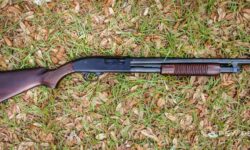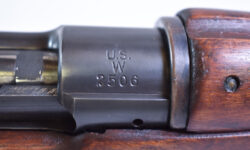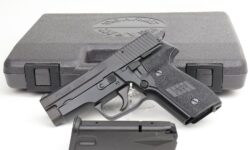WHAT DO THE NUMBERS MEAN ON A RIFLE SCOPE?
Rifle scopes can be used for a variety of purposes. For one thing, they alleviate the shooter’s concern about aligning the front and rear sights and losing focus on the target while aligning the sights. Additionally, rifle scopes magnify the image, which makes hitting the target much easier. Moreover, the numbers on the scope indicate the lens’s size and magnification power.
What Do the Numbers Mean on a Rifle Scope: the Numbers Involved
The numbers on a rifle scope may appear confusing at first, but they are easy to read once you understand how they work. Consider the following examples from a mid-range rifle scope.
Assume you’re using a mid-range variable power scope with the markings 3 – 9 x 40 mm. Three things are indicated by this number. The 3 represents the scope’s minimum magnification, the 9 represents the scope’s maximum magnification, and the 40 mm represents the objective lens’s diameter. Thus, you have a scope magnification range of 3 to 9x in this example.
The first two numbers indicate the magnification range of the scope. The fact that the number ranges from 3 to 9 means that the scope can be zoomed between 3x and 9x magnification.
Variable power riflescopes have the magnification range indicated by the first two numbers. You have something along the lines of 3-9, 4-16, 5-25, and so forth. This also indicates the scope’s zoom range. A scope with a lower magnification, for example, 3-9, has a zoom range of 3x (9 divided by 3). A scope with a higher magnification might be a 5-25x with a 5x zoom range. Recently, variable power scopes with 10x zoom ranges have entered the market. Such a rifle scope, for example, one with a magnification range of 1-10x, enables the scope to cover a broad range of shooting and hunting scenarios.
This is especially true for rifle scopes equipped with adjustable zoom. A fixed power scope will display only a single number, such as 6 x 45, where the first number indicates the fixed magnification of 6 and the second number indicates the lens diameter.
Size of the Objective Lens
Generally, larger lenses with a larger diameter are preferable to smaller lenses. A larger objective lens allows for more light to enter the scope, which makes focusing easier. It results in a significantly brighter and more detailed image, especially when shooting in low light conditions such as cloudy weather or dusk.
Rifle scope lenses are typically smaller than binocular lenses. This is because binoculars are designed to allow you to see as far as they can, whereas rifle scopes only will enable you to see as far as the rifle’s shooting range. Creating rifle scopes with larger lenses is pointless if your rifle can only shoot at a range of 600 yards.
Additionally, your rifle scope does not require an objective lens as large as a pair of binoculars, as you will be zooming in on a single target and will not be viewing a large area through the scope. On the other hand, the spotting scope should allow as much light as possible into the binoculars, allowing you to see a larger field clearly when scouting for deer during a hunt.
Another reason rifle scopes are smaller is that they must be mounted and carried on the rifle. When the scope lens is increased in size, it becomes heavier, and the shooter may have difficulty balancing the gun due to the scope’s added weight.
Finally, if you’re going to use a scope with a large objective diameter, you’ll need a rifle and mounts capable of supporting such a large scope. If your scope has a 56mm objective lens, you’ll need mounts and rings that are capable of supporting such a large lens!
How to Calculate the Zoom Range of a Scope?
The amount of available light heavily influences the effective zooming range of your rifle scope in the area. While your scope may have a zoom range and magnification power of 5-25x, if there is insufficient light around you, you will likely be unable to obtain a clear sight image at magnifications greater than the minimum of 5x.
The image’s clarity and brightness are also influenced by the glass’s quality and finishing processes. Ascertain that the scope’s lens has a coating that enhances light transmission and reduces the likelihood of reflection or glare in bright conditions.
The scope features two primary lenses. The ocular lens is the lens at the back that is closest to your eye. The objective lens is the lens at the front that is furthest from your eye. If you look at the ocular lens from approximately a foot away, you will notice a beam of light. This beam indicates the amount of light transmitted to the naked eye. When the magnification is reduced, the image becomes sharper.
Exit Pupil and Magnification
The exit pupil of a scope can be calculated by dividing the objective lens’s diameter by the scope’s magnification level. If you use a scope with a focal length of 4–7 x 60 mm, you can calculate the exit pupil at various magnifications using the formula below.
At a magnification of 4 = 60 / 4 = 15 mm, the exit pupil
At a magnification of 5 = 60 / 5 = 12 mm, the exit pupil
Exit pupil at 6 = 60 / 6 = 10 mm magnification
Pupil exit diameter at magnification 7 = 60 / 7 = 8.57 mm
The human pupil can expand to a maximum of approximately 8 mm in almost complete darkness. If you shoot during the day, the glare from your surroundings will cause your pupils to contract. Your eye will not perceive the entire field of vision created by the 60 mm lens at 4x magnification. [sc name=”faq2questions” q1=”The Numbers Involved” a1=”Assume you’re using a mid-range variable power scope with the markings 3 – 9 x 40 mm. Three things are indicated…” q2=”Size of the Objective Lens” a2=”Generally, larger lenses with a larger diameter are preferable to smaller lenses. A larger objective lens allows for more light to enter the scope …” ]


